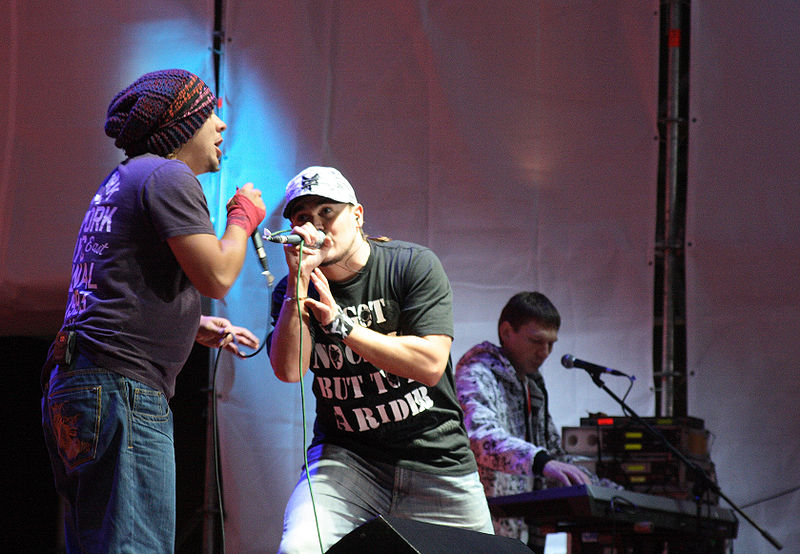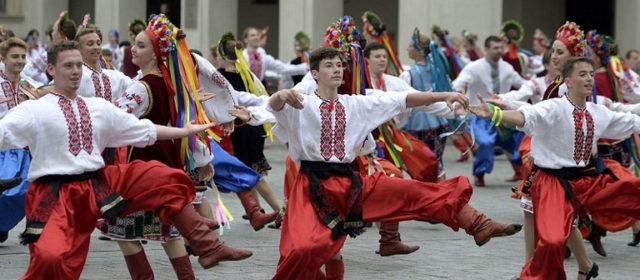Vocal singing is a very strong tradition in Ukraine. While they rarely use complicated time signatures or keys, their use of harmonies can be more complex with their use of solo singing, heterophonic, homophonic, and polyphonic singing. Call and response is also heard in some folk singing.
Folk dances vary from region to region. Some of the more well-known dances include the Kozachok (a type of 16th century Cossack dance), the Trepak (another Cossack dance from Ukraine and Russia), Hopak (originally a male dance that changed over time to include mixed groups), and the Kolomyjka (combines fast-paced dance music with comedic verses). However, dances from other areas of Europe were also just as popular in Ukraine as well, like the polka, mazurka, and the waltz.
Quite a few instruments are used in Ukrainian music, including several string instruments like a type of lute called the kobza, a bass lute called the torban, a 3-stringed cello called the basolya, a hurdy-gurdy, and others. Folk music also utilizes woodwind instruments like a type of flute called the sopilka, another type of end-blown flute called the floyara, an alpenhorn called trembita, and a type of bagpipes called volynka. But it wouldn’t be complete without a set of percussion instruments like a frame drum known as a buben, tambourines, jaw harps, and kettledrums.
 |
| Torban |
I feel like when it comes to classical music, the study of Western music tends to focus on the music generated from only certain countries (Germany, Austria, Italy, France, England, Russia) with a few others of note because of a few composers (Norway, Czech Republic, Finland, Hungary, Poland). Not only are there quite a few Ukrainian composers (like Mykola Lysenko, who’s considered the father of Ukrainian classical music; and Mykola Leontovych, who is famous because of his arrangement of the folk song “Shchedryk,” known to many in North America as “Carol of the Bells”), but there are also many composers from elsewhere in Europe who studied and worked in Ukraine and used themes from Ukrainian folk songs in some of their own works (like Bartók, Beethoven, Dvorák, Haydn, Kabalevsky, Mussorgsky, Prokofiev, Rachmaninoff, Tchaikovsky, and von Weber).
 |
| Mykola Lysenko |
So, I did sample through some Ukrainian musicians. First of all, I listened to some piano music by Mykola Lysenko, and that’s some nice stuff right there. I might even try to find the sheet music for some of his pieces. It has a lot of feeling behind it; just technical to sound impressive, but probably not so technical that I couldn’t figure it out. Related, I also listened to some of the music of Roman Miroshnichenko, a classical guitarist. He is fantastic to listen to, and he isn’t afraid to pull in sounds from other cultures, like incorporating a sitar and Latin elements.
 |
| Ruslana |
Next, there is a lot of pop music from Ukraine that I listened through: Ruslana (she won the Eurovision Song Contest in 2004), Vremya i Steklo (a duo, more of a dance/pop group with elements of EDM), Zlata Ognevich (participated in Eurovision 2013), Anastasia Prikhodko (known for her contralto voice; mixes rock, folk, and pop), Maruv (more dance/pop/EDM), and Jamala (she won Eurovision 2016).
And there are also a lot of rock bands from here as well: Okean Elzy (an alternative rock band, can be quite melodic at times), The Hardkiss (participated in Eurovision 2016, shifts between harder and softer rock), Marrakech (alternative rock, one of their songs was used in the Grand Theft Auto IV soundtrack), Robots Don’t Cry (a little punk/ska yet a little garage band, I really like them), and Zhadan i Sobasky (ska band, equally as fun to listen to).
 |
| Make Me Famous |
While there are quite a few metal bands, I took a listen to one called Make Me Famous. Their lyrics are in English, and they also seem to have someone doing the growled lyrics and someone singing the melodic parts. I like their style.
 |
| TNMK |
And I only found one hip-hop group: TNMK (stands for Tanok na Maidani Kongo, or Dance at the Congo Square). It’s kind of odd because at first listen, I was sort of like, "It's alright," but when the vocals came in, it got better. Even though I don’t understand a word of it. Is that important, though? (Probably.)
Up next: the food




No comments:
Post a Comment